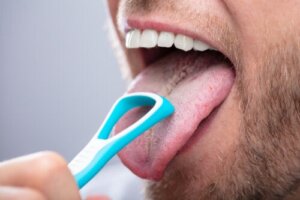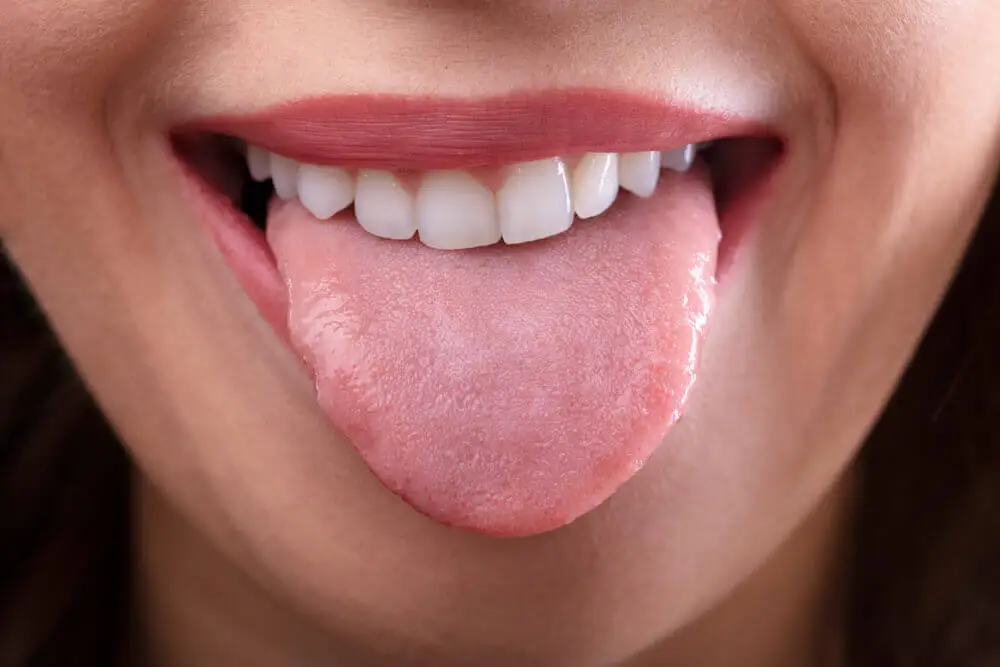How to Clean the Tongue


Written and verified by the dentist Vanesa Evangelina Buffa
When performing daily oral hygiene, taking care to brush all teeth helps prevent many of the common diseases in the oral cavity. However, in addition, cleaning the tongue as part of the routine is essential to maintain the health of your mouth.
The tongue is a muscle involved in essential functions, such as chewing, swallowing, sensing flavors, speaking, and moisturizing the mouth. Its normal appearance is pink, shiny, and moist.
If the tongue is not properly cleaned, food debris and bacteria accumulate on its surface, which can cause oral problems. In this article, we’ll tell you how to clean it to keep it healthy.
The anatomy of the tongue
Before telling you how to clean the tongue, it’s important to know its anatomy. This way, you will be able to understand more about the structure you’re cleaning and why it’s so important to take care of this key organ.
The tongue is a mobile organ composed of a group of muscles covered with mucous tissue and anchored to the floor of the mouth. It has nerve endings and great blood irrigation, which makes it hurt and bleed a lot when it’s injured.
Its dorsal surface is covered by papillae; some of these structures participate in the taste function, while others provide the ability to touch and perceive textures. They also have lymphatic and saliva-producing functions.
Its normal appearance is pink, shiny, moist, and mobile, especially in the anterior sector. It’s part of the following functions of the mouth:
- Chewing: The tongue directs food towards the chewing surfaces to be crushed.
- Formation of the food bolus.
- Swallowing: It directs the food bolus towards the pharynx to be swallowed.
- The perception of the sense of taste.
- Touch and perception of textures.
- Speech and pronunciation of many phonemes.
- Suction.
- Hydration of the mouth with the production of saliva.
We think you may be interested in reading this, too: Your Tongue Can Reveal The State of Your Emotions and Health
5 tips for cleaning the tongue
As we already advanced, cleaning the tongue every day is essential to keep this organ healthy. Here are 5 tips to do it properly.

1. Regularly clean your whole mouth
The first step to cleaning the tongue properly is to incorporate its hygiene into your dental hygiene routine. Start by brushing your teeth with a soft bristle brush and fluoride toothpaste.
It’s also important to use dental floss to remove plaque and food debris that accumulates between the teeth. Starting with proper hygiene of the teeth allows you to remove debris that may be loose in the mouth and then deposited on the tongue.
2. Use a scraper to clean your tongue
To clean the tongue properly, the key is to have a tongue cleaner or scraper. This tool is specially designed to remove the buildup of bacteria from the surface of the tongue.
If this tool is not available, you can use a toothbrush, the back of a toothbrush, or even a dessert spoon. Although a scraper is ideally designed to clean the tongue surface, for many people the bristles of the regular toothbrush are sufficient.
Scraping movements should be made, without exerting too much pressure, from the deepest area of the tongue forward, reaching the tip. It’s important to repeat the process several times, cleaning the sides and all the grooves. Between each pass, your mouth should be rinsed with water.
Placing the scraper in the posterior area of the tongue may generate a gag reflex. Taking a deep breath before starting is often helpful.
3. Observe the tongue surface
Once the cleaning is complete, it’s a good idea to hold your tongue out in front of a mirror and observe it. Looking closely at the surface of the tongue allows you to check that the cleaning has been carried out correctly.
If the hygiene has been adequate, the entire surface should be pink. If white or yellowish areas are observed, it’s because it hasn’t been cleaned completely, and the process should be repeated.
In general, a whitish tongue is due to the presence of bacteria accumulated on its surface, but sometimes it’s the symptom of a disease. Oral candidiasis, leukoplakia, or lichen, for example, may manifest itself in this way.
If the tongue dorsum turns the usual pink color when brushing again, there’s no need to worry. If, on the other hand, the whitish coloration persists, you should see your dentist for an evaluation of the situation.
4. Use mouthwash
To finish the process of cleaning the tongue, the best option is to use a mouthwash with fluoride or an antiseptic. Rinse vigorously for two minutes with the liquid to remove any remaining dirt.
It also helps protect the mouth against the action of bacterial plaque and provides clean, fresh breath.
Like this article? You may also like to read: 9 Things Your Tongue Is Trying to Tell You About Your Health
5. Frequent cleaning
As you incorporate the habit of cleaning your tongue into your toothbrushing routine, start doing it every time you clean your mouth. However, until this becomes a habit, brushing at least twice a day is the minimum necessary.
This prevents bacterial buildup, the formation of whitish saburra plaque on the back of the tongue, and bad breath. When a person experiences the comfort of having a clean tongue, he/she begins to pay more attention to the care of this area.
Why is it important to clean the tongue?
The tongue is a fundamental muscle for the fulfillment of many functions in the mouth. As we’ve already told you, it’s involved in chewing, the formation of the alimentary bolus, swallowing, speech, the perception of flavors, and oral hydration. Cleaning the tongue is important to keep this organ healthy and for these practices to develop normally.
If food debris accumulates and bacteria proliferate on its surface, several problems can arise:
- Bad breath or halitosis
- The development of bacteria that cause cavities, gingivitis, and periodontal disease
- Alterations in sense of taste
- Changes in the normal oral flora, favoring the development of mycosis
- Saburral tongue
If the cleaning of the tongue becomes difficult, whitish stains that are difficult to remove, or pain or difficulty in movement appear, you should consult your dentist. A thorough examination will allow for a diagnosis of the causes of these problems.

The importance of dental check-ups
Cleaning the tongue is essential for it to be able to perform its functions normally. However, to take care of this muscle properly, you should visit a dentist regularly, since apart from good hygiene, this is the best way to ensure the health of your mouth.
The professional can observe the appearance of your tongue and evaluates its mobility to diagnose any alteration that may be present in this organ. He or she will also be able to advise you on the proper ways to keep it healthy. Keep in mind that for your oral care to be complete, it’s always necessary to be responsible for getting regular dental checkups.
All cited sources were thoroughly reviewed by our team to ensure their quality, reliability, currency, and validity. The bibliography of this article was considered reliable and of academic or scientific accuracy.
- James P, Worthington HV, Parnell C, Harding M, Lamont T, Cheung A, Whelton H, Riley P. Chlorhexidine mouthrinse as an adjunctive treatment for gingival health. Cochrane Database Syst Rev. 2017 Mar 31;3(3):CD008676. doi: 10.1002/14651858.CD008676.pub2. PMID: 28362061; PMCID: PMC6464488.
- SALUD, LLEVAR AL MUNDO HACIA UNA, and BUCODENTAL OPTIMA. “Cáncer oral.”
- Van Tornout, M., et al. “Halitosis y cubrimiento lingual.” Rev. Periodoncia y Osteointegración 24.1 (2014): 17-23.
- Asakawa M, Takeshita T, Furuta M, Kageyama S, Takeuchi K, Hata J, Ninomiya T, Yamashita Y. Tongue Microbiota and Oral Health Status in Community-Dwelling Elderly Adults. mSphere. 2018 Aug 15;3(4):e00332-18. doi: 10.1128/mSphere.00332-18. PMID: 30111628; PMCID: PMC6094060.
- López, Catherine, et al. “Función gustativa en gerontes: comparación de la influencia de dos técnicas de higiene lingual en ancianos de cuatro hogares geriátricos de Cali.” Estomatología 13.1 (2005): 20-30.
- Tigselema Mena, Selene Estefanía. Enjuagues bucales para el control de placa bacteriana. BS thesis. Universidad de Guayaquil. Facultad Piloto de Odontología, 2020.
- Bollen CM, Beikler T. Halitosis: the multidisciplinary approach. Int J Oral Sci. 2012 Jun;4(2):55-63. doi: 10.1038/ijos.2012.39. PMID: 22722640; PMCID: PMC3412664.
- Rhyn S, Zürcher A, Ortiz V, Filippi A. The Efficiency and Acceptance of a Suction Tongue-Cleaning Device in Adults. Swiss Dent J. 2020 Feb 6;130(4). Epub ahead of print. PMID: 32024347.
- Victorio-Pérez, Jhoana, Wilfredo Mormontoy-Laurel, and María Elena Díaz-Pizán. “Conocimientos, actitudes y prácticas de padres/cuidadores sobre salud bucal en el distrito de Ventanilla.” Revista Estomatológica Herediana 29.1 (2019): 70-79.
This text is provided for informational purposes only and does not replace consultation with a professional. If in doubt, consult your specialist.








